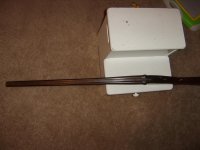May not have a name on it
It is built like an old Ithaca I have, but a lot of guns were. Splinter fore end, pistol grip stock, double triggers, almost certainly a pre-WWII gun, possibly a pre WW I era gun. Could even be pre 1900. It looks like you have solid steel barrels, but its very hard for me to tell from the pictures.
By solid steel, I mean not twist barrels. Often called Damascus barrels, there were different grades of twist barrels. "Damascus" the "good grade" to people of the era were made from 6 or 8 straps of steel, wrapped around a mandrel and hammer welded together. Guns made with 2 or 4 straps were called "stub twist" or just "twist". After 1900, guns began showing up with "solid" steel barrels, known under the names of "fluid steel, Nickel Steel, Nitro steel" and a couple others. This meant the barrels were bored steel, and safe for smokleless powder loads.
Your .410, with no markings, no engraving, no maker's name, means it was a bargin gun. Please check carefully (maybe take it to a gunsmith) to be sure it doesn't have twist barrels. Lower grade twist barrels may not be easy to spot after a century or so of the blueing turning to brown. Look for what looks like faint stripes or rings around the barrels.
Twist barrels, even the high grade ones are NOT SAFE with SMOKELESS POWDER ! It is possible for rust to develope inside the metal itself, where it cannot be seen, weakening the barrel, which was none too strong to begin with. Strong enough for black powder, but they can come "unravelled" from the different pressure of a smokeless powder shell.'
Even if it has twist barrels, it may have given decades of good use with smokeless ammo, and come apart the next time a shell is fired in it! My Grandfather had a "stub twist" Ithaca 12ga, which he loved. A neighbor talked him into selling it to him, and he replaced it with a new gun, with "fluid steel" barrels, in 1909. I have that gun. He told me his old stub twist gun blew out a barrel on his neighbor in the 1940s!

Even though your family has hunted with that gun for generations, I urge you to have a good gunsmith check it over carefully, and if it does have twist barrels, retire it to a place of honor on the wall.
These old guns with twist barrels may not be safe even with black powder ammo, due to the age and possible deterioration of the barrel welds. The best (safest) thing to do is make then a wall hanger. If a good gunsmith gives it a clean bill of health, then enjoy your heirloom. But please, have it checked by someone who knows these old guns well, before you shoot it again, just in case.





